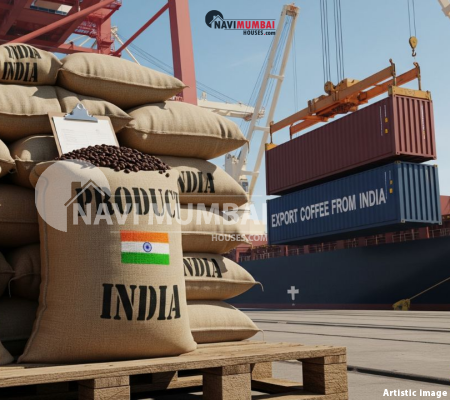
In his latest monthly radio show, the 127th edition of Mann Ki Baat, Prime Minister Narendra Modi declared that Indian coffee is “becoming very popular all over the world.” He cited regions like Chikkamagaluru, Coorg, and Hassan (Karnataka), Nilgiris and Annamalai (Tamil Nadu), Wayanad, Travancore and Malabar (Kerala), and even non-traditional areas such as Koraput (Odisha) as part of this rise.
This public recognition signals a shift: India’s coffee industry is no longer confined to domestic cups and café culture, but stepping onto the global stage.
A. Export and Value-Add Growth
According to data, India’s coffee exports for April-February 2025 surpassed US$1.54 billion, representing a substantial jump from earlier years. The premise is simple: rising global demand for specialty coffees + India’s unique growing regions + increasing value-added production = strong tailwinds.
Moreover, India ranks as the seventh-largest coffee producer globally, with unique Arabica and Robusta blends, and the opportunity to climb higher.
B. Diversity of Growing Regions
One major strength is geography. India’s coffee comes from high-altitude, shade-grown plantations across the Western and Eastern Ghats — offering flavour profiles increasingly sought after in global markets. PM Modi emphasised this when he said:
“Be it Chikmagalur, Coorg, and Hassan in Karnataka; … or the areas of Wayanad, Travancore, and Malabar in Kerala … the diversity of Indian coffee is truly remarkable.”
Also noteworthy: areas outside the traditional belts are entering the mix (e.g., Koraput in Odisha), signalling expansion and new opportunities.
C. Farmer Livelihoods & Brand Identity
PM Modi pointed not only to exports, but to the human story behind the beans:
“…they liked coffee so much that they entered this field and are now successfully working in it. There also are many women whose lives have been pleasantly transformed by coffee.”
The narrative here is dual: Indian coffee is gaining global acclaim and generating income, social upliftment, and identity for growers.
For Farmers & Growers
The global recognition means premium pricing, demand for specialty lots, and impetus to invest in quality, certification (organic, fair trade), and branding. States like Karnataka are already focusing on customised & speciality varieties.
For Industry & Exporters
Coffee exporters and brands have a chance to evolve from commodity sellers to brand-builders: emphasising origin stories (“Coorg estate”, “Nilgiri high-altitude”), flavour profiles, and value-added products (roasted beans, single‐origin).
For Consumers & Global Markets
For global coffee drinkers, this is a chance to experience Indian terroir — not just a cup of filter coffee in India, but Indian origins on café menus worldwide. For domestic consumers, the prospect of “Indian grown, globally recognized” coffee enhances pride and demand.
For Policy & Economy
Coffee’s rise supports India’s rural economy, export ambitions, and ‘Vocal for Local’ branding. It aligns with food-and-agri export growth targets, diversification of agricultural value chains, and sustainable livelihoods.
-
Quality & Certification push: Growers should focus on high-altitude Arabica, traceability, and shade-grown practices to meet global specialty standards.
-
Branding and origin marketing: Exporters should communicate Indian origin, region, and story; consumers globally respond to authenticity.
-
Expand cultivation: Non-traditional regions (Odisha, Northeast) can be scaled carefully, with climate and environmental safeguards.
-
Value addition: Move beyond raw beans to roasted, packaged, single‐origin labels — greater margin, global brand presence.
-
Policy supports: Governments (Central + states) should target infrastructure (processing, drying, export hubs), marketing support (embassies, trade shows), and farmer empowerment.
-
Sustainable practices: Given the environmental sensitivities of coffee belts (biodiversity, forest cover, shade trees), growth must be balanced with conservation.
Conclusion
When the Prime Minister of India declares “Indian coffee is becoming very popular all over the world,” he isn’t simply sharing a fact — he is signalling a strategic shift. Indian coffee’s story is now global, rooted in distinctive terroirs, farmer livelihoods, and export growth. For a crop that started from Baba Budan’s seven seeds centuries ago, this is a leap. If the momentum is sustained — and value-addition, branding, and sustainability are prioritised — Indian coffee could become a global brand, one cuppa at a time.
Visit Us: Navimumbaihouses.com or Call Us @ 8433959100
The post “Brewed in India, Loved by the World”: PM Modi Spotlights Indian Coffee’s Global Rise appeared first on .

